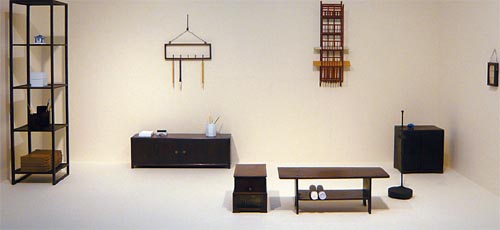Perfect furniture pieces for persnickety Joseon scholars

The “Hardwood Furniture and the Life of the Classical Scholars of the Joseon Dynasty” exhibition displays about 80 pieces of furniture from the Joseon Dynasty. Provided by Shinsegae Gallery
Neat. Precise. Simple but not too humble. These are the adjectives that best describe the furniture at the exhibition “Hardwood Furniture and the Life of the Classical Scholars of the Joseon Dynasty,” which is now on display at Shinsegae Gallery in crowded and bustling downtown Seoul.
The exhibit features about 80 pieces of furniture and other items used by scholars in the Joseon Dynasty (1392-1910), which was known for its embrace of Confucian values.
“It must not have been easy to be a classic scholar in the Joseon era,” said Park Young-gyu, a member of the Cultural Heritage Administration, who planned and directed the exhibition. “Since there were so many directions and rules to follow just for arranging the furniture, there must have been far more rules regulating their everyday lives. The furniture and room layout in the exhibit allow us speculate about what their lives must have been like.”
Many of the pieces in the exhibition are privately owned. Korean painters Seo se-ok, Jeong Min-ja and Kim Jong-hak contributed their furniture pieces to the exhibition. The Horim Museum and Lock Museum also contributed artifacts to the exhibition.
Much of the furniture from the Joseon period was made of wood, creating a warm and comfortable ambience.
However, not every type of wood is the same, and the classical scholars were particular about the kind of wood that could be used to make their furniture.
Many of the pieces in this exhibition are made of wood from the royal foxglove tree, which is not only light and smooth, but also has a simple pattern. This neat pattern is further refined by the Nakdong technique, a finishing process that involves slightly burning the surface of the wood and scratching away the burned parts with dry straw. This made the surface shine in a natural way, in contrast to the lacquer that was popular in other eras.
In addition, different types of trees were used for different purposes. Old persimmon trees, whose bark is pitch black and has an attractive pattern, were used for various kinds of stationary goods. Ginkgo trees, which are soft enough for elaborate engravings, were used to make wooden pillows, Go game boards and armrests.
Wood is difficult to work with, and it is very sensitive to moisture, sunlight and temperature. Due to the big differences in temperature in summer and winter in Korea, wooden furniture had to be made with gaps between the edges to allow it to expand in the heat and contract in the cold.
One of the remarkable things about these furniture pieces is that they are very well-proportioned. Their length, width and thickness are “just right.” That is another remnant of the legacy of the Joseon Dynasty.
For example, a calligraphy writing brush hanger from the 19th century is so well-proportioned that it looks like a modern interior accessory designed by a professional. In this way, the furniture on display shows just how well Koreans mastered not only the artistic but also the technical in making these pieces.
“Everything is where it should be and nothing is out of place,” said Chung Yang-mo, a former director of the National Museum of Korea. “The room, the furniture and the people in the room are united. It is almost impossible to feel awkward or out of place in such a room.”
*The exhibit continues through July 25 at Shinsegae Gallery, which is located on the 12th floor of Shinsegae Department Store in Chungmuro, central Seoul.
Hours are 10:30 a.m. to 8 p.m. on weekdays and 10:30 a.m. to 8:30 p.m. on weekends.
Go to Hoehyeon Station, line No. 4, exit 7, or Myeong-dong Station, line No. 4, exit 4. For more information, call (02) 310-1921.
By Chung Jae-suk [estyle@joongang.co.kr]










with the Korea JoongAng Daily
To write comments, please log in to one of the accounts.
Standards Board Policy (0/250자)